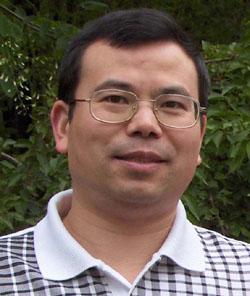|
Tang X, Lu H, Ramratnam B.
"Neurotoxicity of HIV-1 Tat is attributed to its penetrating property." Scientific reports, vol. 10, no. 1, 2020, pp. 14002.
|
|
Lu H, Tang X, Sibley M, Coburn J, Rao RSP, Ahsan N, Ramratnam B.
"Impact of exosomal HIV-1 Tat expression on the human cellular proteome." Oncotarget, vol. 10, no. 54, 2019, pp. 5632-5644.
|
|
Tang, Xiaoli, Lu, Huafei, Dooner, Mark, Chapman, Stacey, Quesenberry, Peter J., Ramratnam, Bharat.
"Exosomal Tat protein activates latent HIV-1 in primary, resting CD4+ T lymphocytes." JCI Insight, vol. 3, no. 7, 2018.
|
|
Kwei K, Tang X, Lok AS, Sureau C, Garcia T, Li J, Wands J, Tong S.
"Correction for Kwei et al., “Impaired Virion Secretion by Hepatitis B Virus Immune Escape Mutants and Its Rescue by Wild-Type Envelope Proteins or a Second-Site Mutation”." Journal of Virology, vol. 91, no. 24, 2017, pp. e01655-17.
|
|
Lunagariya, Jignesh, Zhong, Shenghui, Chen, Jianwei, Bai, Defa, Bhadja, Poonam, Long, Weili, Liao, Xiaojian, Tang, Xiaoli, Xu, Shihai.
"Design and Synthesis of Analogues of Marine Natural Product Galaxamide, an N-methylated Cyclic Pentapeptide, as Potential Anti-Tumor Agent in Vitro." Marine Drugs, vol. 14, no. 9, 2016, pp. 161.
|
|
Tang X, Zheng D, Hu P, Zeng Z, Li M, Tucker L, Monahan R, Resnick MB, Liu M, Ramratnam B.
"Glycogen synthase kinase 3 beta inhibits microRNA-183-96-182 cluster via the β-Catenin/TCF/LEF-1 pathway in gastric cancer cells." Nucleic acids research, vol. 42, no. 5, 2014, pp. 2988-98.
|
|
Tang X, Wen S, Zheng D, Tucker L, Cao L, Pantazatos D, Moss SF, Ramratnam B.
"Acetylation of drosha on the N-terminus inhibits its degradation by ubiquitination." PLoS ONE, vol. 8, no. 8, 2013, pp. e72503.
|
|
Kwei K, Tang X, Lok AS, Sureau C, Garcia T, Li J, Wands J, Tong S.
"Impaired virion secretion by hepatitis B virus immune escape mutants and its rescue by wild-type envelope proteins or a second-site mutation." Journal of Virology, vol. 87, no. 4, 2013, pp. 2352-7.
|
|
Tang X, Li M, Tucker L, Ramratnam B.
"Glycogen synthase kinase 3 beta (GSK3β) phosphorylates the RNAase III enzyme Drosha at S300 and S302." PLoS ONE, vol. 6, no. 6, 2011, pp. e20391.
|
|
Qin Y, Tang X, Garcia T, Hussain M, Zhang J, Lok A, Wands J, Li J, Tong S.
"Hepatitis B virus genotype C isolates with wild-type core promoter sequence replicate less efficiently than genotype B isolates but possess higher virion secretion capacity." Journal of Virology, vol. 85, no. 19, 2011, pp. 10167-77.
|
|
Gao JS, Zhang Y, Tang X, Tucker LD, Tarwater PM, Quesenberry PJ, Rigoutsos I, Ramratnam B.
"The Evi1, microRNA-143, K-Ras axis in colon cancer." FEBS Letters, vol. 585, no. 4, 2011, pp. 693-9.
|
|
Tang X, Zhang Y, Tucker L, Ramratnam B.
"Phosphorylation of the RNase III enzyme Drosha at Serine300 or Serine302 is required for its nuclear localization." Nucleic acids research, vol. 38, no. 19, 2010, pp. 6610-9.
|
|
Zhang Y, Gao JS, Tang X, Tucker LD, Quesenberry P, Rigoutsos I, Ramratnam B.
"MicroRNA 125a and its regulation of the p53 tumor suppressor gene." FEBS Letters, vol. 583, no. 22, 2009, pp. 3725-30.
|
|
Tang X, Gao JS, Guan YJ, McLane KE, Yuan ZL, Ramratnam B, Chin YE.
"Acetylation-dependent signal transduction for type I interferon receptor." Cell, vol. 131, no. 1, 2007, pp. 93-105.
|
|
Wang X, Tang X, Li M, Marshall J, Mao Z.
"Regulation of neuroprotective activity of myocyte-enhancer factor 2 by cAMP-protein kinase A signaling pathway in neuronal survival." Journal of Biological Chemistry, vol. 280, no. 17, 2005, pp. 16705-13.
|
|
Wang X, Tang X, Gong X, Albanis E, Friedman SL, Mao Z.
"Regulation of hepatic stellate cell activation and growth by transcription factor myocyte enhancer factor 2." Gastroenterology, vol. 127, no. 4, 2004, pp. 1174-88.
|
|
Marshall J, Dolan BM, Garcia EP, Sathe S, Tang X, Mao Z, Blair LA.
"Calcium channel and NMDA receptor activities differentially regulate nuclear C/EBPbeta levels to control neuronal survival." Neuron, vol. 39, no. 4, 2003, pp. 625-39.
|
|
Gong X, Tang X, Wiedmann M, Wang X, Peng J, Zheng D, Blair LA, Marshall J, Mao Z.
"Cdk5-mediated inhibition of the protective effects of transcription factor MEF2 in neurotoxicity-induced apoptosis." Neuron, vol. 38, no. 1, 2003, pp. 33-46.
|

